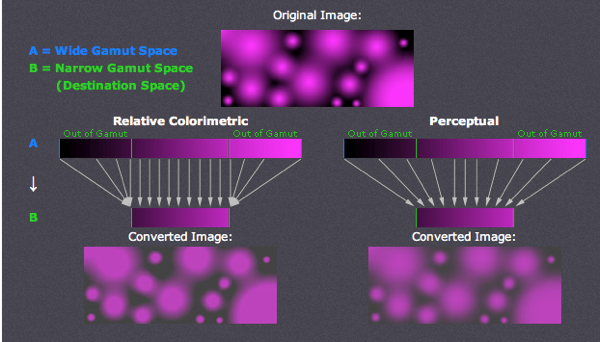We are constantly faced with the choice for printing photographs of using either Perceptual color or Relative color. If you print mostly black and white, like I do, then you easily forget which setting does what. Paper, ink and time are too expensive to waste, so I have put some references here to resources I use in helping me make that choice.
The image below is from Cambridge In Colour and their post on Colour Space Conversion. This is their image and it has been useful to me on more than one occasion to easily explain the difference between Relative and Perceptual.
If you are graphical, like me, you can now see that Relative color spaces take the low and high range of colors that are out of the Gamut and compresses them to one color. Note that the Gamut is the range of colors in the end result. So, for printing, the Gamut is the range of colors that the ink provides on the specific paper used for the print. Even in film photography, the Gamut of the paper was always less than that of the film. In fact, the resulting image on photographic paper printed in a dark room from negatives, uses Relative color spaces. If a shadow is composed of several very dark tones on a negative, and these tones do not exist in the Gamut of the photographic paper, each tone may come out as black. This would mean the detail would be lost because the various dark tones on the negative were only one tone on the photographic paper.
So what is Perceptual color? Perceptual color is like using a filter on an enlarger to change contrasts from the negative to the photographic paper. Perceptual color takes the entire range of tones in an image, including the out of Gamut tones, and compresses them to fit the Gamut of the ink and paper. Thus, the resulting tones all give the perception (key word) of the difference between the dark and light tones. However, Relative color leaves all the color tones exactly as they are and chops off the high and low tones by keeping them all one dark shade or one light shade depending on which tones are out of Gamut.
In general, I use Perceptual color when printing from Adobe Lightroom. If your color Gamut has really weird choices, you may need to experiment with Relative. For example, if you have very high saturation in a variety of colors and very dark and light tones, it is possible that your print will look better in Relative color.
So, if you were expecting the ultimate answer, I am sorry to disappoint you and say – ‘It depends.’ My first choice, and most all of my color prints, use Perceptual. So, I would start there!
